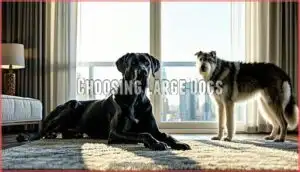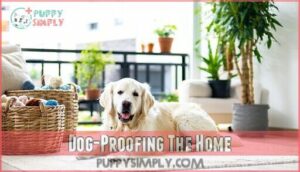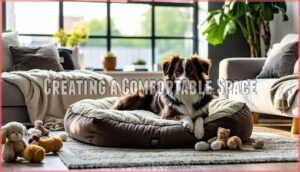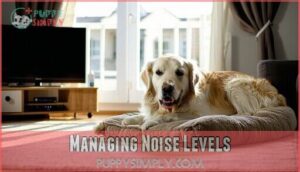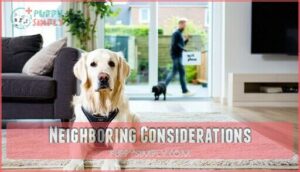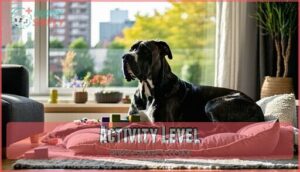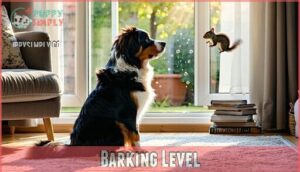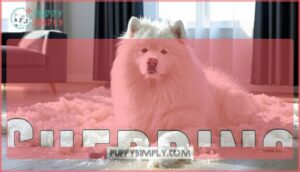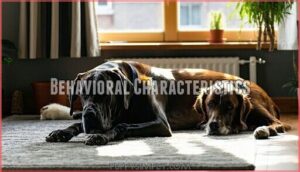This site is supported by our readers. We may earn a commission, at no cost to you, if you purchase through links.
 You don’t need a backyard to enjoy life with a gentle giant! Many large apartment dogs like Great Danes, Greyhounds, and Mastiffs actually thrive in smaller spaces due to their surprisingly low energy levels.
You don’t need a backyard to enjoy life with a gentle giant! Many large apartment dogs like Great Danes, Greyhounds, and Mastiffs actually thrive in smaller spaces due to their surprisingly low energy levels.
They’re often content to lounge on your couch like oversized throw pillows. You’ll need to commit to daily walks and consider your building’s pet policies, but these calm companions can adapt well to apartment living despite their size.
The key is choosing breeds with the right temperament—not all big dogs need sprawling estates to be happy. Some large breeds might actually be better roommates than their smaller, more energetic counterparts, making them a great choice for apartment living with a low maintenance lifestyle.
Table Of Contents
- Key Takeaways
- Choosing Large Dogs
- Apartment Living Essentials
- Large Breed Characteristics
- Care and Exercise Needs
- Successful Apartment Ownership
- Frequently Asked Questions (FAQs)
- Which big dog is best for an apartment?
- Is it okay to have a big dog in an apartment?
- What type of dog can be left alone during the day?
- What do apartments consider a large dog?
- Are there any breeds that are particularly well-suited for apartment living?
- What are some tips for training a large dog in an apartment?
- How do I know if my apartment is suitable for a large dog?
- How can I prevent my large dog from bothering my neighbors in an apartment?
- Cost differences between large and small dogs?
- How to introduce large dogs to children?
- Conclusion
Key Takeaways
- You don’t need a backyard for large dogs—many giants like Great Danes, Greyhounds, and Mastiffs thrive in apartments due to their surprisingly low energy levels and calm temperaments.
- You’ll want to focus on temperament over size when choosing a large apartment dog—look for breeds with gentle natures, low barking tendencies, and manageable exercise requirements.
- You should establish daily routines that include quality walks, mental stimulation activities, and regular training to keep your large dog happy and well-behaved in your apartment.
- You’ll need to consider practical aspects like creating comfortable spaces for your dog, managing shedding through regular grooming, respecting neighbors, and checking your building’s pet policies before bringing home a large breed.
Choosing Large Dogs
When choosing a large dog for apartment living, you’ll want to think beyond just their size.
Consider their energy level, temperament, and how well they’ll fit into your space and routine.
Space Requirements
Living with large dog breeds in an apartment means considering their turning radius and breed size.
Big dogs often dominate furniture, so focus on durability.
Vertical space also helps—use shelves for belongings.
Prioritize comfort by creating cozy areas.
Large dog apartment living works if space considerations, like room to stretch out, are balanced with smart layouts for dog comfort.
Exercise Needs
A large dog’s exercise needs aren’t about miles of jogging but balanced indoor games, outdoor activities, and mental stimulation.
Prioritize exercise quality over quantity with a consistent routine of daily exercise. Think play sessions or brisk park walks for essential large dog apartment exercise.
Meeting dog exercise requirements guarantees they stay happy, healthy, and burn off extra energy effectively. A great way to do this is through challenging puzzle toys, which provides mental stimulation and helps with exercise quality.
Breed Temperament
When picking large apartment dogs, focus on breed temperament.
Calmness indoors is essential, and many breeds like Great Danes and Mastiffs have a gentle nature perfect for small spaces.
Look for quiet large apartment dogs with a guarding instinct but manageable energy levels.
Breed compatibility matters—ensure their personality complements your lifestyle for a happy home and content, low-energy large dogs.
Grooming Needs
Grooming needs for large apartment dogs vary by coat types.
Some, like Greyhounds, require minimal upkeep, while others, like Newfoundlands, need regular grooming.
Shedding control is essential—weekly brushing can work wonders.
Plan for routine nail trimming and occasional baths to keep them healthy.
Professional grooming may be necessary for thick-coated breeds, keeping your apartment fur and odor-free!
Health Considerations
Health is essential for large apartment dogs.
These breeds often face unique challenges, so prioritize their well-being with proper care.
- Joint Health: Large breeds can develop arthritis or dysplasia.
- Bloat Risk: Avoid feeding right before exercise.
- Weight Management: Overfeeding escalates health issues.
- Dental Care: Regular cleaning prevents disease.
Stay on top of their care for a happy, healthy companion.
Apartment Living Essentials
Living in an apartment with a large dog means planning for their comfort and keeping your space functional.
From managing noise levels to creating a cozy corner, a little preparation goes a long way.
Access to Outdoor Spaces
When you’re raising large dog breeds in an apartment, access to outdoor spaces is key.
Regular trips to dog parks or walks along scenic walking routes help manage their exercise needs.
Even a balcony can work as a quick, fresh-air spot between potty breaks.
Apartment living thrives with creative solutions, so prioritize outdoor options for your dog’s happiness and health.
Dog-Proofing The Home
Dog-proofing your home for apartment-friendly large dog breeds isn’t hard but takes planning.
Start with these steps:
- Hide toxic hazards like cleaners and plants.
- Manage cords to avoid chewing disasters.
- Protect furniture durability with washable covers.
Consider using non-toxic cleaning solutions for added safety.
Add chew toys to channel their energy and secure balconies to prevent accidents.
Large dogs in small spaces need safe, practical setups!
Creating a Comfortable Space
Transform your space into a haven for large dog breeds in apartments by creating safe zones with durable furniture and temperature control.
A cozy dog bed and thoughtful toy selection help keep your furry friend relaxed and entertained.
For large dogs good in apartments, comfort is key—choose items that suit their size and guarantee a comfortable apartment they’ll love.
Consider buying a spacious sleeping area for your large breed.
Managing Noise Levels
Managing noise levels with large dog breeds in apartments requires planning.
Identify barking triggers and use positive reinforcement training techniques like teaching “quiet” commands.
Consider soundproofing tips, like thick curtains, to limit noise.
Some breeds have lower vocalization; choose wisely to avoid noise complaints.
Background noise, like a TV, can calm dogs while reducing external sound distractions for peaceful apartment living with positive reinforcement.
Neighboring Considerations
Keeping neighbors happy means respecting noise levels and shared spaces.
Barking can strain relationships, so follow pet etiquette and train for quiet moments.
Check building rules and pet policies to avoid surprises.
Remember, breed perception matters—some neighbors may worry about large dogs.
Good communication can guarantee your furry friend is welcome and keeps the peace.
Some breeds, like the Basenji, are known for low barking tendencies, which can be ideal for apartment living.
Large Breed Characteristics
When you’re considering a large breed for your apartment, it’s important to look beyond their size and think about traits like activity level, barking, and trainability.
These characteristics help you understand if the dog will adapt comfortably to your space and lifestyle.
Activity Level
How much exercise does a large dog need in an apartment? Surprisingly, it’s more about quality than quantity.
Many large dogs, like Great Danes, enjoy lounging indoors after a good walk. Add mental engagement with indoor games to keep their minds sharp.
Breed energy varies, but outdoor access is essential. Large dog exercise needs thrive on routine, not chaos.
Barking Level
Excessive barking isn’t common in most apartment-friendly large dogs, but Breed Vocalization varies.
Mastiffs are famously quiet, while Bernese Mountain Dogs bark when alerting.
Training Solutions help calm Barking Triggers, like loud noises or boredom.
If barking leads to Noise Complaints, address it early.
With patience and consistency, large dogs can be good in apartments despite occasional noise.
Trainability
Good training builds harmony between you and your large dog.
Some breeds, like Golden Retrievers, excel due to high intelligence and willingness to please, making Apartment commands a breeze. Others, like Great Danes, respond well with patience and gentle guidance.
Socialization importance remains strong—early exposure curbs problem behaviors. German Shepherds are also known for their trainability.
Use consistent training methods suited to your dog’s personality and apartment life.
Shedding
What’s the deal with shedding? It’s manageable with apartment-friendly large dogs!
Use these tips:
- Choose hypoallergenic breeds like Standard Poodles for fewer loose hairs.
- Grooming tools, like de-shedding brushes, handle fur effectively.
- Diets impact shedding—feed your dog quality food to keep coats healthy.
Large dogs good in apartments don’t have to mean hairy chaos with the right shedding management!
Behavioral Characteristics
Large dogs often surprise you with their calmness indoors, adapting beautifully to apartment life.
Their gentle temperament and natural guarding instincts make them wonderful companions.
They’re loyal, loving, and often goofy, bringing joy without chaos.
Here’s a quick overview of apartment-friendly large dog breed temperament:
| Trait | Example Breeds | Notes |
|---|---|---|
| Calmness Indoors | Mastiff, Great Dane | Relaxed, minimal indoor activity. |
| Gentle Temperament | Golden Retriever | Lovable and playful with everyone. |
| Guarding Instincts | Greyhound, Mastiff | Protective but rarely aggressive. |
| Energy Management | Rhodesian Ridgeback | Needs regular but not intense exercise. |
| Exercise Adaptation | Greyhound | Thrives with occasional sprints. |
Energy management is key, with exercise adaptation customized to individual needs.
Care and Exercise Needs
Caring for a large dog in an apartment means balancing their physical and mental needs with your space limitations.
Regular walks, engaging activities, and proper grooming keep them happy and healthy, without turning your home into a chew-toy battlefield, which requires proper care and attention to maintain harmony.
Daily Exercise Routine
A solid apartment dog daily exercise routine includes morning walks (15-30 minutes) and evening strolls to meet exercise needs.
Mix in indoor exercise like hide-and-seek or tug-of-war. For large dog breeds, apartment playtime ideas like stair runs or hallway fetching work wonders.
Weekend adventures, like park visits, offer stimulation. Walk frequency and creative alternatives keep your dog happy and healthy.
Regular vet checkups are essential for maintaining superior health.
Mental Stimulation
Keeping your big dog’s brain busy is just as important as physical exercise.
Mental stimulation, especially in large dog breeds in apartments, prevents boredom and destructive behavior.
Prevent boredom and destructive behavior with mental stimulation to keep large apartment dogs engaged and content every day.
Try these boredom busters:
- Puzzle toys for snack-filled fun.
- Training games to boost their confidence.
- Scent work for curious noses.
- Socialization activities during playtime.
- Obstacle courses using household items.
Your dog will love the challenge!
Socialization and Training
Engaging your dog’s mind is just one piece of the puzzle; teaching them early socialization and proper apartment etiquette is just as important.
Focus on consistent dog training, leash manners, and calm greetings so they’re a welcomed presence.
For large dog breeds in apartment living, clear apartment dog training strategies keep everyone—neighbors included—happy.
Health and Nutrition
Meeting your large dog’s health and nutrition needs is a must for happy apartment living.
Follow these tips:
- Prioritize joint health: Opt for food rich in glucosamine.
- Practice portion control: Prevent obesity and joint stress.
- Enhance coat quality: Choose omega-3-packed diets.
- Stay consistent with preventative care: Regular vet check-ups catch issues early.
A good diet keeps tails wagging!
Regular Grooming
Healthy grooming habits keep your large dog happy in apartment living.
Brush regularly to manage shedding control, especially for double coats.
Clip nails to prevent discomfort and scratches on floors.
Proper nail trimming requires the right tools, so consider using specialized dog clippers.
Prioritize dental hygiene and ear cleaning—neglect here can lead to issues.
Apartment-friendly large dogs thrive with consistent care, and it guarantees your space stays clean and welcoming for everyone.
Successful Apartment Ownership
Owning a large dog in an apartment takes careful planning and commitment, but it’s completely doable when you’re prepared.
By managing your time, budget, and lifestyle to meet your dog’s needs, you can create a happy living situation.
Time Commitment
Caring for large dogs in apartments means dedicating time every day.
You’ll balance exercise, training, and bonding. Here’s what to expect:
- Daily walks: At least 30–60 minutes to stretch those legs.
- Training schedule: Practice behavior basics weekly.
- Playtime needs: Mental games curb boredom.
- Grooming time: Manage shedding and hygiene.
- Vet visits: Plan routine checkups proactively.
Financial Considerations
While time with your large dog is priceless, your wallet needs preparation.
Initial costs for big breeds range from $560-2,000, covering adoption fees and essentials.
Annually, expect $700-1,500 for vet bills, $200-900 for food expenses, and up to $1,400 for grooming.
Don’t forget apartment-specific pet rent ($25-75 monthly) and insurance costs ($30-60 monthly).
Emergency vet visits can reach $2,000, so budget for these unexpected expenses too.
Lifestyle Compatibility
Your personality and daily schedule play a big role in choosing a compatible breed.
Apartment-friendly large dogs like Great Danes thrive with relaxed owners who value shared activities.
A dog’s temperament and social needs should match your lifestyle.
If long work hours are your norm, consider breeds content with solo downtime but make sure they feel included when you’re home, as their need for inclusion is crucial for a harmonious relationship with an owner who values shared activities.
Dog Daycare and Sitters
Juggling a busy schedule with a large dog in an apartment requires backup plans.
When you can’t be there, reliable dog daycare or sitters become essential.
Compare costs between professional dog walking, doggy daycare, and private sitters while checking their qualifications and emergency protocols.
Quality daycare also offers valuable socialization opportunities for your large breed, helping fulfill their social needs when your time commitment is limited, and provides a sense of community.
Building a Strong Bond
After a long day, your large canine companion deserves your undivided attention.
Building trust with apartment dogs requires consistent training and understanding their communication cues.
Spend quality time on shared activities like puzzle games for mental stimulation.
Different breed temperaments respond uniquely to affection displays—some large dog breeds prefer gentle pets while others enjoy energetic play.
This bonding strengthens your relationship and makes apartment living harmonious for both of you, through quality time.
Frequently Asked Questions (FAQs)
Which big dog is best for an apartment?
Like a gentle giant curled up on a sofa, Greyhounds make excellent apartment companions.
You’ll find Great Danes and Mastiffs are also surprisingly well-suited with their calm temperaments and low energy needs.
Is it okay to have a big dog in an apartment?
Yes, you can have a big dog in an apartment.
Many large breeds like Mastiffs, Great Danes, and Greyhounds actually adapt well to smaller spaces as long as you provide sufficient exercise and mental stimulation.
What type of dog can be left alone during the day?
Independent breeds like Greyhounds, Basset Hounds, and adult Mastiffs can handle being alone during workdays.
You’ll need to provide morning exercise, a midday break if possible, and proper mental stimulation toys.
What do apartments consider a large dog?
Most apartments consider dogs over 50 pounds to be "large".
You’ll find weight limits typically range from 25-75 pounds, depending on the property’s policies.
Always check your lease agreement for specific restrictions.
Are there any breeds that are particularly well-suited for apartment living?
Incredibly, several breeds defy expectations in apartments.
You’ll find Greyhounds, Great Danes, Mastiffs, and Standard Poodles are well-suited for apartment living due to their calm temperament and surprisingly low energy needs.
What are some tips for training a large dog in an apartment?
Prioritize consistency with daily training sessions.
Establish a designated training area, use positive reinforcement, and practice quiet commands.
Consider soundproofing techniques and focus on apartment-specific behaviors like controlled barking and calm greetings.
How do I know if my apartment is suitable for a large dog?
Check your apartment’s size, pet policies, noise tolerance, and access to outdoor spaces.
You’ll need room for a large bed, toys, and clear pathways.
Consider your dog’s energy level and exercise needs too.
How can I prevent my large dog from bothering my neighbors in an apartment?
Train your dog to minimize barking, provide enough exercise daily, use sound-absorbing rugs, maintain regular grooming, and establish a consistent routine. Consider soundproofing materials and address noise complaints promptly.
Cost differences between large and small dogs?
Large dogs cost more than small ones for food, medication, grooming, and supplies.
You’ll spend 2-3 times more on food alone, plus larger beds, crates, and toys that withstand bigger jaws.
How to introduce large dogs to children?
Supervise all interactions, making gradual introductions with both parties calm.
Teach your child proper handling techniques and respect for the dog’s space.
Always monitor their time together, rewarding positive behavior from both.
Conclusion
Welcoming a gentle giant into your apartment isn’t just possible—it’s rewarding.
With the right breed selection and proper preparation, large apartment dogs can flourish in smaller spaces.
Remember that temperament trumps size when choosing your oversized companion.
You’ll need to commit to regular exercise and consider building rules, but you’ll gain a loyal, calm roommate in return.
The perfect large dog doesn’t need a mansion—just your love and attention.

